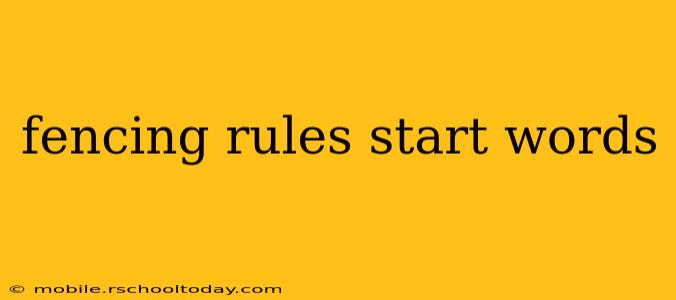Fencing, a thrilling blend of athleticism, strategy, and precision, is governed by a comprehensive set of rules designed to ensure fair play and exciting competition. Understanding these rules is crucial, whether you're a spectator captivated by the speed and grace of the sport or an aspiring fencer eager to begin your journey. This guide breaks down the fundamental fencing rules, providing a clear and concise overview for newcomers.
Starting a Fencing Bout: The Basics
Before the clash of steel, several crucial steps initiate a fencing bout. These preliminary actions set the stage for the competitive exchange, ensuring a fair and controlled environment.
The En Garde Position
The bout begins with both fencers in en garde, a specific stance that allows for both defense and rapid attack. This position involves:
- Footwork: A staggered stance with one foot slightly ahead of the other, providing balance and agility.
- Blade position: The weapon held in the dominant hand, pointing towards the opponent, but not threateningly so.
- Body posture: An upright yet flexible position, ready to respond to the opponent’s movements.
A judge verifies the fencers are correctly positioned before initiating the bout.
The Ready Position
Following en garde, the fencers move to the "ready" position on the command of the referee. This position is similar to en garde, but with a greater degree of readiness and alertness for immediate action. The referee will typically call "Ready," then "Fence!" to start the action.
Understanding the Referee's Signals
The referee plays a crucial role in governing the bout, signaling actions and judging touches. Their commands and signals, including "Halt," "Touché," and "Reprise," are essential for maintaining order and ensuring fairness. Learning to understand these signals is vital for both participants and spectators alike. These signals are usually accompanied by a hand gesture, clear commands, and visual cues.
Scoring a Touch: What Constitutes a Valid Hit?
Scoring a touch is at the heart of fencing. A valid touch requires precise execution and adherence to specific rules regarding:
Target Area
Valid touches are only scored when the weapon makes contact with a specific target area:
- Foil: The torso (from the shoulders to the groin, front and back).
- Épée: The entire body, including the head and limbs.
- Sabre: The entire body above the waist, including the head and arms.
These distinctions are critical, as a touch outside the designated target area won't be scored, even if it seems impactful.
Right of Way (Foil and Sabre)
In foil and sabre, the right-of-way rule determines which fencer scored a valid touch. The referee determines who initiated the action and maintained control in the exchange. If both fencers hit simultaneously, the referee will often favor the fencer who had “right-of-way”. Understanding this rule is critical to advanced fencing strategy. It doesn't apply to épée, where all simultaneous hits are scored.
Touché!
When a valid touch is made, the referee will call "Touché!" and the score will be updated. This is a critical moment in the bout, and it's important for both fencers to remain focused on the referee’s decision. Disputes are rarely common due to the use of electronic scoring systems.
Penalties in Fencing: Maintaining Fair Play
Fencing rules include penalties for infractions that disrupt the flow of the competition or impede fair play. Common penalties include:
- Violation of the right-of-way: In foil and sabre, this results in a point for the opponent.
- Illegal actions: Such as lunging outside the piste boundary or improper weapon handling.
- Unsportsmanlike conduct: Showing disrespect to opponents, the referee, or other participants.
Penalties can significantly influence the outcome of a bout, emphasizing the importance of sportsmanship and adherence to the rules.
Conclusion: Mastering the Rules of Fencing
Understanding these fundamental fencing rules is essential for anyone involved in or interested in this captivating sport. From the starting position to scoring a touch and dealing with penalties, mastering these rules enhances the appreciation of the athleticism, skill, and strategy involved in fencing. The combination of strategy, skill, and precise execution defines the essence of this refined and thrilling competition. While this overview provides a foundation, further research and practical experience are crucial to fully comprehend the intricacies of fencing regulations.
